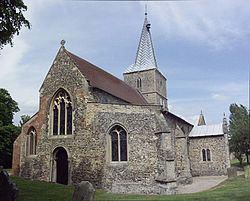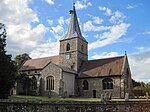Ickleton
| Ickleton | |
| Cambridgeshire | |
|---|---|
 Ickleton, St Mary Magdalene | |
| Location | |
| Grid reference: | TL492437 |
| Location: | 52°4’12"N, 0°10’12"E |
| Data | |
| Population: | 655 (2001) |
| Post town: | Saffron Walden |
| Postcode: | CB10 |
| Dialling code: | 01799 |
| Local Government | |
| Council: | South Cambridgeshire |
| Parliamentary constituency: |
South Cambridgeshire |
| Website: | http://www.ickletonvillage.co.uk |
Ickleton is a village in Cambridgeshire, right on the Essex border. It grew up at the point where the ancient Icknield Way crosses the River Cam, so it is likely that some form of habitation has existed on the site since prehistoric times. However, the present layout of the village probably dates mainly from the late Anglo-Saxon period.
Cambridge lies about 12 miles to the north, and Saffron Walden about five miles to the south. The River Cam (or Granta) forms the eastern border of the village.
Houses are mainly grouped around three streets, Abbey Street, Frogge Street, and Church Street, which leads into Brookhampton Street. The village itself lies at the eastern end of the parish which stretches for a couple of miles to the west amidst rolling farmland.
Ickleton Recreation Ground on Frogge Street has been designated a Queen Elizabeth II Field.
Name
The village is listed as Icelingtune in the 10th century and Hichelintone in the Domesday Book. The name is Old English; Icelinga tun means "The Icelings' estate".
While in most cases Icelingas would be an otherwise unknown clan named after a man named Icel, the Iclingas are known to history as the ancient kings of the Angle tribe (the Englas) who founded dynasties as Kings of East Anglia and of Mercia; King Icel according to legend ruled the English in the original homeland of Angeln in Schleswig. The name of the Icknield Way, which passes through the village, might have the same origin, though the path is old even than King Icel.
Church
The focal point of the village's architecture is its parish church, St Mary Magdalene, which is undoubtedly one of the most important in East Anglia. It dates from the 11th century and contains a series of early wall paintings of the 12th and 14th centuries revealed after a serious fire in 1979.
History
There has been a settlement at Ickleton for at least two thousand years. The pre-Roman Icknield Way runs through the parish, and in Roman times there was a villa in the village, not far from a nearby Roman fort at Great Chesterford.
The mediæval village was dominated by Ickleton Priory that was founded in the mid-12th century. Despite its small size, the village prospered in the 15th and 16th century.[1]
The Domesday Book of 1086 shows that the village then had a population of about 250. By the time the railway arrived in 1845, the population had grown somewhat and today Ickleton is home to about 650 people. [1]
Economy
Throughout its history, agriculture and related trades have been almost the only economic activity. It was only after the Second World War that farming ceased to predominate. Today, Ickleton's farms are hugely more productive than they were, even in the 1940s, yet they employ only a small number of people. Like many other rural villages, most of the working population is now employed elsewhere, in Cambridge, other towns nearby, or in London.
There are a few small businesses in the village and a village shop. The Wellcome Trust Genome Campus is in Hinxton, less than one mile away.
The village has one remaining pub: The Lion in Abbey Street was open by 1728. Former pubs include The Rose Inn and The Bell, both mentioned in the 16th century. The White Lion south of the green burned down at the end of the 17th century to be replaced on the same site by The Chequer (18th century) and then The Duke of Wellington in the 19th century which closed in around 1957. The New Inn in Brookhampton Street was open in the late 19th century and The Greyhound in the south of the parish on the edge of Great Chesterford was open by 1851 but closed in the late 20th century.[1]
Outside links
| ("Wikimedia Commons" has material about Ickleton) |
References
- ↑ 1.0 1.1 1.2 A History of the County of Cambridge and the Isle of Ely, vol 6 (1978) pages 230–246
